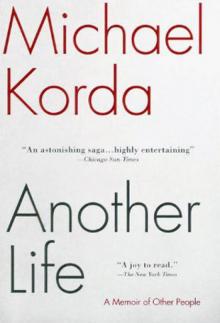- Home
- Michael Korda
Clouds of Glory
Clouds of Glory Read online
Dedication
For Margaret
Epigraph
The past is never dead. It’s not even past.
—William Faulkner, Requiem for a Nun
Our birth is but a sleep and a forgetting:
The soul that rises with us, our life’s star,
Hath elsewhere had its setting,
And cometh from afar:
Not in entire forgetfulness,
And not in utter nakedness,
But trailing clouds of glory do we come
From God, who is our home.
—William Wordsworth,
“Ode: Intimations of Immortality from
Recollections of Early Childhood”
Contents
Dedication
Epigraph
List of Maps
PREFACE: The Portent
CHAPTER 1: “Not Heedless of the Future”
CHAPTER 2: The Education of a Soldier
CHAPTER 3: The Engineer—1831–1846
CHAPTER 4: The Perfect Warrior—Mexico, 1846–1848
CHAPTER 5: A Long Peace—1848–1860
CHAPTER 6: 1861—“The Thunder of the Captains and the Shouting”
CHAPTER 7: The Seven Days—“The Power of the Sword”
CHAPTER 8: Triumph and Tragedy—Second Manassas and Sharpsburg
CHAPTER 9: Glory—Fredericksburg and Chancellorsville
CHAPTER 10: Gettysburg—“If We Do Not Whip Him, He Will Whip Us”
CHAPTER 11: Lee and Grant
CHAPTER 12: Apotheosis—1865–1870
Picture Section
Acknowledgments
Notes
Bibliography
Index
About the Author
Also by Michael Korda
Credits
Copyright
About the Publisher
List of Maps
1. Sketch map of the Battle of Cerro Gordo.
2. The approach to Churubusco.
3. Cheat Mountain.
4. Distribution of the Confederate forces in Virginia, as of the morning of March 24, 1862, and the assumed positions of the opposing United States forces.
5. The Shenandoah Valley.
6. Approximate situation in front of Richmond, about May 22, 1862, showing defensive disposition of Johnston’s army and the approach of McClellan.
7. Area between Chickahominy and Pamunkey rivers, showing watershed (unprotected, according to Stuart’s report) down which Jackson was to advance.
8. Plan of battle north of the Chickahominy River, as announced by General Lee at the council of war, June 23, 1862.
9. The crude map of the vicinity of Richmond, used by the Confederate high command during the Seven Days of battles of 1862.
10. Route of Jackson, Ewell, and Branch, June 26, 1862.
11. Battlefield of Gaines’s Mill, June 27, 1862, with sketch of Jackson’s line of advance.
12. Lines of advance by the Army of Northern Virginia, morning of July 1, 1862.
13. Longstreet’s plan for “converging fire” at Malvern Hill.
14. The junction of the Rappahannock and Rapidan rivers.
15. Situation at the close of action, August 29, 1862.
16. Battle of Second Manassas, or Bull Run, August 30, 1862.
17. Lee’s approach to Maryland.
18. The approach to Sharpsburg.
19. Battle of Sharpsburg (or Antietam), September 17, 1862.
20. Position of the major units of the Army of Northern Virginia at the opening of the battle of Fredericksburg, December 13, 1862.
21. The approach to Chancellorsville.
22. Position of the Army of Northern Virginia and assumed position of the Army of the Potomac, about 5 a.m., May 3, 1863.
23. Lines of Confederate advance from Williamsport into Maryland and Pennsylvania, June–July, 1863.
24. Battle of Gettysburg, July 2–3, 1863.
25. Parts of a hook. Drawing from flytyinginstruction.com.
26. Objective of the Confederate assault of July 3, 1863, on the right center at Gettysburg, showing the contours (intervals of four feet) and the nature of the obstructions.
27. Hotchkiss sketch map of the Confederate positions around Spotsylvania Court House, May 1864, after Grant’s advance through the Wilderness.
PREFACE
The Portent
In October 1859, Brevet Colonel Robert E. Lee,* commanding the Second U.S. Cavalry, in Texas, was home on leave, laboring to untangle the affairs of his late father-in-law’s estate. Despite a brilliant military career—many thought him the most capable officer in the U.S. Army—he was a disappointed man. Nobody understood better than Lee how slowly promotion came in this tiny army, or knew more exactly how many officers were ahead of him in the all-important ranking of seniority and stood between him and the seemingly unreachable step of being made a permanent full colonel. He did not suppose, given his age, which was fifty-two, that he would ever wear a brigadier general’s single star, still less that fame and military glory awaited him, and although he was not the complaining type, he often expressed regret that he had chosen the army as a career. An engineer of considerable ability—he was credited with making the mighty Mississippi navigable, which among other great benefits turned the sleepy town of Saint Louis into a thriving river port—he could have made his fortune had he resigned from the army to become a civil engineer. Instead, he commanded a cavalry regiment hunting renegade Indians in a dusty corner of the Texas frontier, and not very successfully at that, and was now home, in his wife’s mansion across the Potomac from Washington, methodically uncovering the debts and the problems of her father’s estate, which seemed likely to plunge the Lees even further into land-poor misery. Indeed, the shamefully run-down state of the Arlington mansion, the discontent of the slaves he and his wife had inherited, and the long neglect of his father-in-law’s plantations made it seem only too likely that Lee might have to resign his commission and spend his life as an impoverished country gentleman, trying to put things right for the sake of his wife and children.
He could not have guessed that an event less than seventy miles away was to make him famous—and go far toward bringing about what Lee most feared: the division of his country over the smoldering issues of slavery and states’ rights.
Harpers Ferry, Sunday, October 16, 1859
Shortly after eight o’clock at night, having completed his preparations and his prayers, a broad-brimmed hat pulled low over his eyes, his full white beard bristling like that of Moses, the old man led eighteen of his followers, two of them his own sons, down a narrow, rutted, muddy country road toward Harpers Ferry, Virginia. They marched silently in twos behind him as he drove a heavily loaded wagon pulled by one horse.
The members of his “army” had assembled there during the summer and early autumn, hiding away from possibly inquisitive neighbors and learning how to handle their weapons. John Brown had shipped to the farm a formidable arsenal: 198 Sharps rifles, 200 Maynard revolvers, 31,000 percussion caps, an ample supply of gunpowder, and 950 pikes. The pikes Brown had ordered from a blacksmith in Connecticut two years earlier—made to his own design at a dollar apiece, they consisted of a double-edged blade about ten inches long, sharpened at both edges, shaped rather like a large dirk or a broad dagger, and intended to be attached to a six-foot ash pole, a weapon that Brown thought might be more effective and terrifying in the hands of liberated slaves than firearms, with which they were unlikely to be familiar.
Brown’s reputation as “the apostle of the sword of Gideon” had been made, for better or for worse, in the widespread guerrilla warfare and anarchy of “bleeding Kansas,” where pro-slavery freebooters from Missouri clashed repeatedly with Free Soilers, settle
rs who were vigorously opposed to the extension of slavery into the territory. Southerners were equally determined to prevent a free state on the border of Missouri, which might render “this species of property”—a current euphemism for slaves—insecure. Violence was widespread and took many forms, from assassination, arson, lynching, skirmishes, and “bushwhacking” to small battles complete with artillery.
Brown had been responsible for the murder of five pro-slavery settlers at Pottawatomie Creek in revenge for the sacking of the antislavery town of Lawrence, Kansas—they had been dragged from their homes in the middle of the night and butchered with broadswords. Brown led the killers, who included two of his sons, and may have given the coup de grâce to one of the victims.
For three years, from 1855 through 1858, a group of Free Soilers under the “command” of “Captain” Brown (or “Osawatomie Brown,” as he was called after his heavily fortified Free Soil settlement) fought pitched battles against “Border Ruffians” (as the pro-slavery forces were known by their enemies), in one of which his son Frederick was killed. Brown achieved fame bordering on idolatry among abolitionists in the North for his exploits as a guerrilla fighter in Kansas, culminating in a daring raid during the course of which he liberated eleven slaves from their masters in Missouri and, evading pursuit despite a price on his head, transported them all the way to freedom across the border in Canada in midwinter.
John Brown was a man of extraordinary courage and persistence, with a grandiose vision and a remarkable gift for organization. Widowed and remarried, he was the father of twenty children by his two wives; a commanding, often intimidating presence even to his enemies; as much at ease in the elegant drawing rooms of the wealthy New England and New York City abolitionists who supported him as he was in the saddle, armed to the teeth, on the plains of Kansas. He was at once a throwback to the undiluted Calvinism and Puritanism of the first New England settlers and far ahead of his time—however opposed they might be to slavery, most abolitionists still shied away from social equality with blacks, but Brown had built his home in New Elba, New York, close to Lake Placid, among freed blacks who ate at the same table as the Browns, and whom he punctiliously addressed as “Mr.” or “Mrs.” When he redrafted the Declaration of Independence and the Constitution for the benefit of his followers, he included not only racial equality, a revolutionary idea at the time, but what we would now call gender equality, giving women full rights and the vote, promising “secure equal rights, privileges, & justice to all; Irrespective of Sex, or Nation.” Brave, unshaken by doubt, willing to shed blood unflinchingly and to die for his cause if necessary, Brown was the perfect man to light the tinder of civil war in America, which was just what he intended to do.
The object of his raid was the U.S. Armory at Harpers Ferry, where 10,000 military rifles a year were manufactured and over 100,000 were stored. Its capture was certain to create a nationwide sensation, and panic in the South; but although Brown was a meticulous planner, his intentions after he captured the armory were uncharacteristically vague. He hoped the act itself would encourage slaves to join his cause, and intended to arm them with rifles if they came in large enough numbers; certainly his intention, once they were armed, was to lead them into the Blue Ridge Mountains, from which they could descend from time to time in larger and larger numbers to liberate more slaves: reenacting the raid into Missouri on a grander and growing scale. When he struck, Brown wrote, “The bees will begin to swarm.”
Careful as his preparations had been, Brown had perhaps waited too long before striking, with the result that his usual energy and decisiveness in action seem to have deserted him just when they were most needed. Unlikely as it may seem, he may have come to believe it would be sufficient to “stand at Armageddon and . . . battle for the Lord,” and the rest would follow. If so, he was underestimating the anger his raid would cause among the 2,500 people who lived in or near Harpers Ferry, or the alarm it would create in Washington, D.C., less than seventy miles away as the crow flies.
His first moves were sensible enough, given the small number of his force and the sprawling size of the armory. Two of his men cut the telegraph wires, while others secured the bridges over the Potomac and the Shenandoah rivers—Harpers Ferry was on a narrow peninsula, where the rivers joined, and not unlike an island—thus virtually isolating the town. Brown took prisoner the lone night watchman at the armory in the brick fire-engine house, a solid structure that he made his command post, then sent several of his men off into the night to liberate as many slaves as they could from nearby farms and bring their owners in as hostages. The western part of Virginia was not “plantation country” with large numbers of field slaves, but Brown had done his homework—one of his men had been living in Harpers Ferry for over a year, spying out the ground, and even fell in love with a local girl who had borne him a son.
Brown was particularly determined to capture Colonel Lewis W. Washington, a local gentleman farmer and slave owner on a small scale, the great-grandnephew of President Washington, and to have the ceremonial sword that Frederick the Great had presented to George Washington placed in the hands of one of his black followers as a symbol of racial justice. Colonel Washington (his rank was an honorary one) was removed in the middle of the night from his rather modest home, Beall-Air, about five miles from Harpers Ferry, and delivered to Brown in his own carriage, along with a pair of pistols that Lafayette had given George Washington, the sword from Frederick the Great, and three somewhat puzzled slaves.
More slaves were soon brought in, and armed with pikes to guard their former owners in the engine house—most either accepted these weapons reluctantly or refused to touch them. Brown now had thirty-five hostages and possession of the armory, but the slave uprising on which he was counting did not take place, and during the night, one by one, things started to go wrong.
The first problem arose when the night watchman’s relief arrived at his post on the Potomac bridge and found it held by armed strangers. He panicked; took a wild punch at Oliver Brown, one of Brown’s sons; then ran, at which point one of Oliver’s companions shot at him, sending his hat flying and grazing his skull. The night watchman, bleeding profusely, rushed into the Galt House, a saloon opposite the hotel and railway station, and raised the alarm, although the sound of a shot in the middle of the night in a peaceful backwater like Harpers Ferry was by itself enough to arouse the curiosity of those who heard it. Then, at 1:25 a.m., the eastbound Baltimore and Ohio train from Wheeling to Baltimore arrived to encounter the bridge blocked by armed men.
The arrival of the train can hardly have come as a surprise to Brown, since all he had to do was consult a Baltimore and Ohio schedule, but it should have been a signal to him to gather up his hostages, their slaves, and as many rifles as he could pack into the wagon, and get out of town and into the hills with his followers while he could. Given his actions over the next few hours, it is hard not to conclude that somewhere in the back of his mind he had already guessed the effect that a courageous last stand and martyrdom would have on public opinion in the North.
In the meantime, the engineer and the baggage master of the train went forward to see what the problem was on the bridge, and were fired on. Sensibly, they returned and backed the train out of range. The shots attracted the attention of the Harpers Ferry station baggage master, Hayward Shepherd, a freed black man well liked and respected by everybody in town, who went toward the bridge to see what was happening, was told to halt, and was then shot in the back and mortally wounded as he turned away. The irony of the fact that the first victim of the raid was a freed black man holding a responsible job would have been painful news to John Brown, who was, however, too far away from the bridge to know about it.
The shot, and Shepherd’s cries of pain, woke Dr. John D. Starry, who lived nearby. He ran to where Shepherd lay to see if he could help the wounded man. Realizing immediately that Shepherd was beyond anything he could do for him, Dr. Starry, an uncommonly courageous man, stayed to give
what comfort to Shepherd he could; then, after observing what was going on in town, he went home, saddled his horse, and began to ride around Harpers Ferry in the spirit of Paul Revere, alerting people to the raid on the armory. He had the presence of mind to send a messenger off to summon the nearest militia, the Jefferson Guard, from Charles Town, the country seat, about eight miles away; he had the church bells rung; and he warned the gathering, puzzled citizens of Harpers Ferry that they had better arm themselves. The bees were beginning to swarm just as John Brown had predicted, but they were not the ones he had in mind.
In the meantime, the train to Baltimore was stuck, since the men holding the bridge refused to let it pass, although they allowed the passengers to walk back and forth. At three in the morning, Brown at last sent word that it could proceed, but the conductor, Phelps, decided it was safer to wait until daybreak before starting. Then Phelps stopped the train at Monocacy, twenty-one miles away, the first stop down the line to the east of Harpers Ferry, to send a telegraph informing W. P. Smith, the B&O’s master of transportation in Baltimore, of what had happened. Phelps reported that his train had been fired on, that a B&O employee had been shot, and that at least 150 “insurrectionists” who had “come to free the slaves” were holding both bridges at Harpers Ferry and had told him they would fire on any further train that attempted to cross.
Smith was surprised and, it is possible to guess, irritated by Phelps’s message. He telegraphed back, “Your dispatch is evidently exaggerated and written under excitement. Why should our trains be stopped by Abolitionists?” From farther down the line at Elicott’s Mills, Phelps replied indignantly that he had not exaggerated, or even “made it half as bad as it is,” but by this time the exchange of messages had already reached the desk of John W. Garrett, the president of the Baltimore and Ohio, and he at once took them more seriously than W. P. Smith. Garrett telegraphed the president of the United States, as well as the governor of Virginia and the commander of the Maryland Volunteers, “that an insurrection was in progress . . . in which free negroes and whites were engaged.”

 Passing
Passing Another Life
Another Life Clouds of Glory
Clouds of Glory Hero: The Life and Legend of Lawrence of Arabia
Hero: The Life and Legend of Lawrence of Arabia Cat People
Cat People Hero
Hero With Wings Like Eagles: A History of the Battle of Britain
With Wings Like Eagles: A History of the Battle of Britain Ulysses S. Grant
Ulysses S. Grant